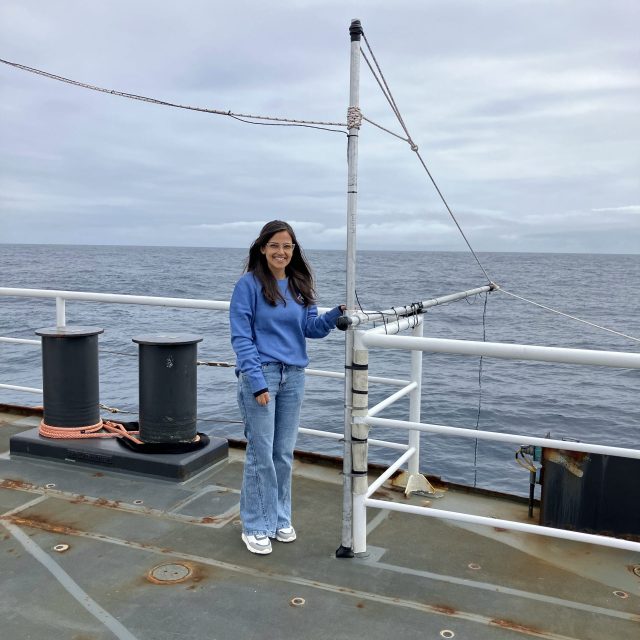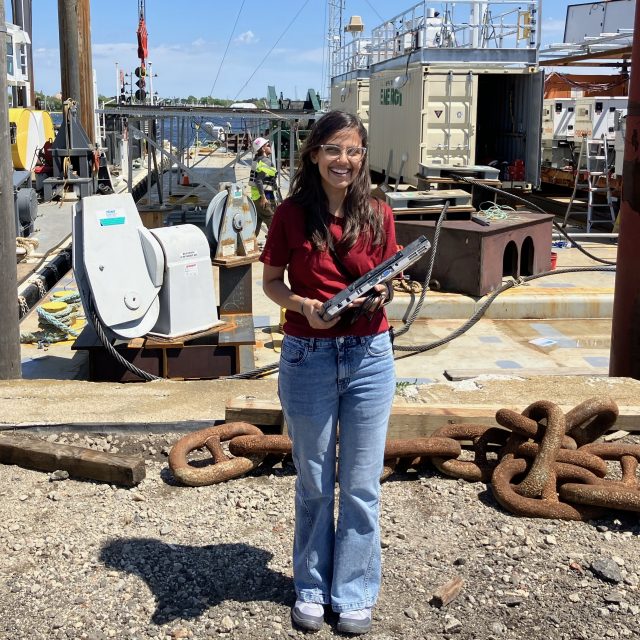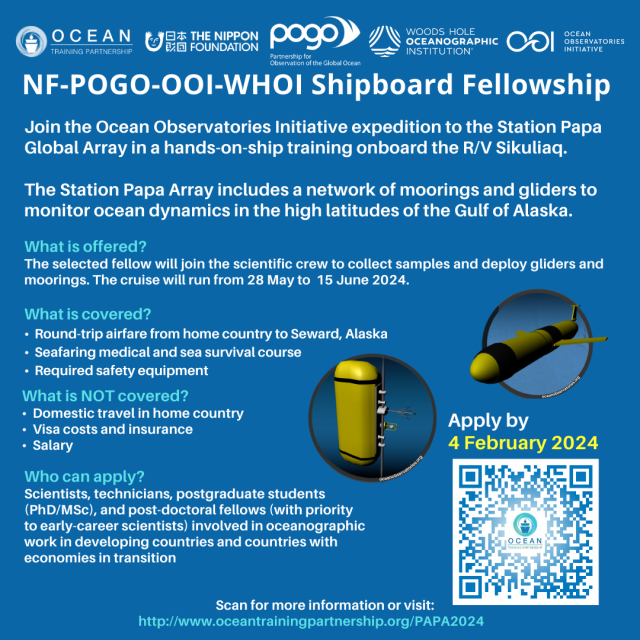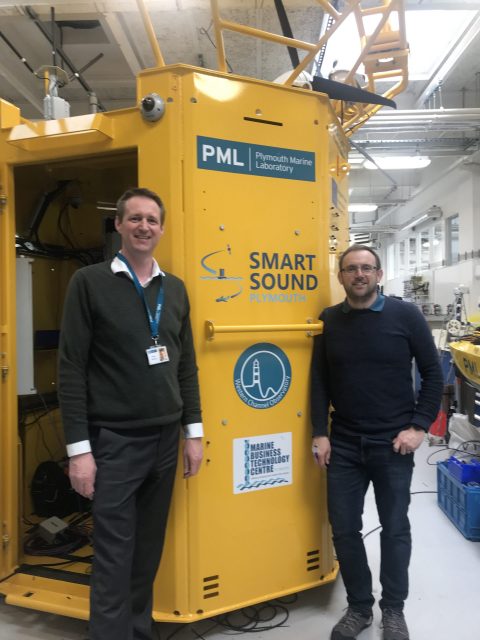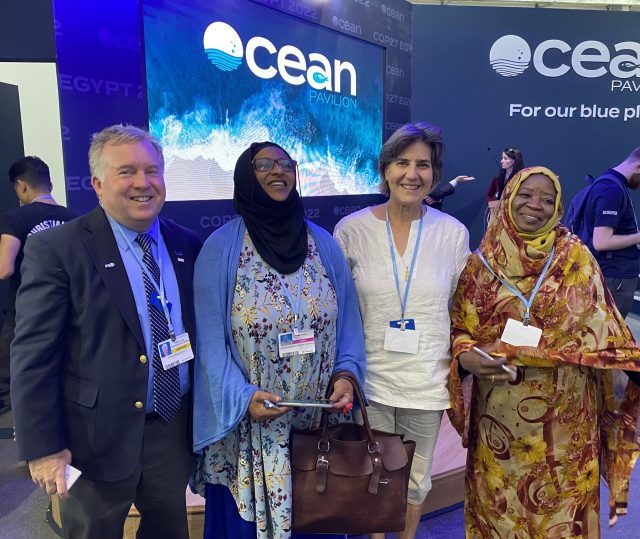Posts Tagged ‘POGO’
POGO Fellow Aditi Sharma Returns from Sea and Reflects on 17-Day Expedition
Partnership for Observation of the Global Ocean (POGO) Fellow Aditi Sharma has returned from a 17-day expedition aboard the R/V Sikuliaq to recover and deploy OOI’s Global Station Papa in the Gulf of Alaska. A PhD candidate at the National Institute of Oceanography India, Aditi was chosen from over 80 applicants for a shipboard training fellowship sponsored by POGO, WHOI, OOI, and the Nippon Foundation.
Back on land, Aditi is reflecting on her time at sea and her goals for the future.
How did you benefit from the training?
The training has been immensely beneficial as it provided me with a chance to engage in work and learn from the experts in the field. The hands-on operations of winch, deployment procedures, data downloading, and calibration techniques have given me confidence in practical skills essential for the fieldwork. These experiences are particularly relevant as I now intend to apply them to my current project at my parent institute, which involves monitoring diverse environmental variables in the coastal Bay of Bengal using advanced meteorological sensors on a fixed mooring buoy. This training has helped in enhancing my capability to contribute meaningful insights to the project. In addition to the scientific aspects, the training has provided me with an understanding of the operational challenges during expeditions. It has highlighted the need for improvisation in adverse weather conditions and emphasized collaborative work approaches. Additionally, it has instilled in me a strong sense of time management that I aim to apply both in my career and in my personal life.
What are your future aspirations?
I am currently working towards my PhD at the National Institute of Oceanography. Upon completing my PhD, I aim to pursue postdoctoral studies and collaborate with fellow scientists in my specialized field. This journey represents a vast ocean of knowledge that I am eager to explore, with a strong desire to effectively share and discuss my insights with peers.
[caption id="attachment_34524" align="alignnone" width="640"]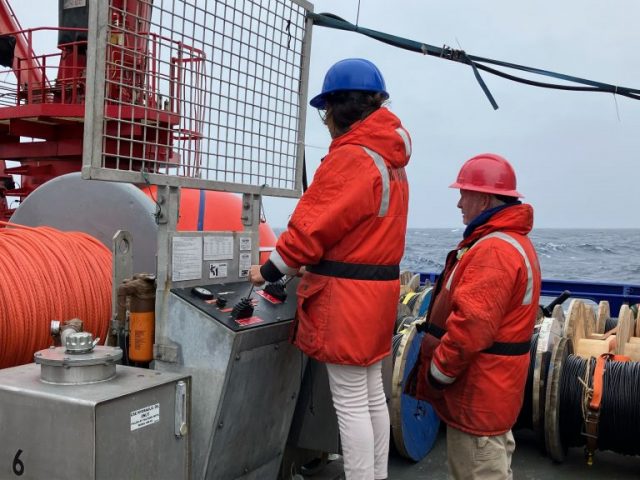 Aditi Sharma aboard R/V Sikuliaq[/caption]
Read More
Aditi Sharma aboard R/V Sikuliaq[/caption]
Read More POGO Fellow Reports on Shipboard Training
Aditi Sharma, a PhD candidate at the National Institute of Oceanography India, was selected from more than 80 applicants for a shipboard training fellowship sponsored by the Partnership for Observation of the Global Ocean (POGO), WHOI, OOI, and the Nippon Foundation. She was aboard the R/V Sikuliaq for a 17-day expedition to recovery and deploy OOI’s Global Station Papa in the Gulf of Alaska. Jim Edson, Principal Investigator for OOI’s Program Management Office, is also onboard as her advisor. In addition to fantail activities, Edson and she will be working on a project to compare near surface “sea-snake” temperature with an infrared radiometer measuring the sea-surface or skin temperature. This will provide hands-on experience at sea and enhance Aditi’s research experience as she works to complete her PhD when she returns to India. Over the course of the expedition, Aditi shared her experiences, which can be read at the link below.
JUNE 14, 2024 Lots to Report!
Sunrise Surprise
Sunrise has become a rare sight after spending ten days onboard in the Gulf of Alaska.
[media-caption path="https://oceanobservatories.org/wp-content/uploads/2024/06/1-scaled.jpg" link="#"]Sunrise view from the bedside window. Credit: Aditi Sharma, NIO.[/media-caption]Tangled Glass Balls
We began retrieving the mooring from the Global Papa 10 Array deployed last year. The most captivating aspect of the operation for me was dealing with the glass balls. These glass balls are often tangled, presenting a fascinating challenge to untangle them, which I found incredibly enjoyable and fun.
[media-caption path="https://oceanobservatories.org/wp-content/uploads/2024/06/2-1-scaled.jpg" link="#"]Retrieval of Acoustic Release accompanied by entangled glass balls. Credit: Aditi Sharma, NIO.[/media-caption] [media-caption path="https://oceanobservatories.org/wp-content/uploads/2024/06/3-1-scaled.jpg" link="#"]Entangled glass balls on deck, awaiting detangling.Credit: Aditi Sharma, NIO.[/media-caption] [media-caption path="https://oceanobservatories.org/wp-content/uploads/2024/06/4-1-scaled.jpg" link="#"]Jim Edson lending a hand in deciphering the tangled puzzle of glass balls.Credit: Aditi Sharma, NIO.[/media-caption]Teamwork on Deck
Following the retrieval of the Global Papa array moorings, the team commenced operations to recover the University of Washington wave rider mooring.
[media-caption path="https://oceanobservatories.org/wp-content/uploads/2024/06/5-1-scaled.jpg" link="#"]Team members assisting in tagging the ropes during the retrieval of the waverider mooring. Credit: Aditi Sharma, NIO.[/media-caption] [media-caption path="https://oceanobservatories.org/wp-content/uploads/2024/06/6-scaled.jpg" link="#"]Recovery of the spheres from the waverider mooring.Credit: Aditi Sharma, NIO.[/media-caption] [media-caption path="https://oceanobservatories.org/wp-content/uploads/2024/06/7-scaled.jpg" link="#"]Mooring covered in biofouling by goose neck barnacles and “sea-slime”. Credit: Aditi Sharma, NIO.[/media-caption]Ocean Wizards or Inflatable Tube-man
The rope connected to the mooring was covered with organisms, creating a mesmerizing, almost wizard-like appearance. Dr. Jim Edson compared these organisms to inflatable tube-man at used-car lots, a comparison I found amusing and wholeheartedly agreed with.
[video width="1280" height="720" mp4="https://oceanobservatories.org/wp-content/uploads/2024/06/v1-1.mp4"][/video]The mooring rope bio-colonized by organisms.
Winch Adventure
Deck Operation Lead Jim Ryder offered me the opportunity to learn how to operate the winch, which I found exhilarating despite the cold weather. Fueled with happiness, my hands worked efficiently as I operated the winch barehanded. Despite his offers for a break, I was too excited to pause, deeply grateful to the team for their guidance and teachings during my learning experience.
[video width="720" height="1280" mp4="https://oceanobservatories.org/wp-content/uploads/2024/06/v2.mp4"][/video]Winch operation following instructions from Deck Operations Lead Jim Ryder.
CTD operations
In addition to deploying moorings and gliders, we performed CTD casts near the deployment locations to gather samples at specific depths using a 24-bottle rosette of Niskin samplers. The samples were collected for analysis of Dissolved Oxygen (DO), Dissolved Inorganic Carbon (DIC), nutrients and conductivity by salt analysis. Apart from sensors for conductivity, temperature, and depth, CTD was equipped with additional sensors for dissolved oxygen, chlorophyll fluorometer, transmissometer, and PAR.
DIC samples were treated with mercuric chloride for preservation prior to storage. Nutrient samples underwent filtration before being stored in the deep freezer, while Dissolved Oxygen samples were analyzed onboard.
[video width="720" height="1280" mp4="https://oceanobservatories.org/wp-content/uploads/2024/06/v3.mp4"][/video]Sample collection using 24-bottle rosette of Niskin samplers via the wet wall.
Spooky dangling figure
As I was doing my laundry after a day’s work, my attention was drawn to the mannequin dressed in safety gear. Ironically, for a moment I didn’t feel safe at all since it actually freaked me out. Well, for a little while.
[media-caption path="https://oceanobservatories.org/wp-content/uploads/2024/06/8-scaled.jpg" link="#"]Safety gear attired mannequin. Credit: Aditi Sharma, NIO.[/media-caption]Spectacular Sunset
[media-caption path="https://oceanobservatories.org/wp-content/uploads/2024/06/9-scaled.jpg" link="#"]The stunning sunset painted the sky, as a masterpiece on a canvas.Credit: Aditi Sharma, NIO.[/media-caption]JUNE 11, 2024 The Giant Hairy Bearded Man
Recovery operations were set to begin once the deployment operations were successfully completed and the decks cleared. A little time was also allotted between the deployment of new and recovery of the old to provide overlapping data to intercalibrate the moored instruments. The recovery operations brought back the old moorings that had been deployed a year ago. Covered with a dense growth of organisms and encrusted with biofouling, with many goose barnacles, the old moorings took on an almost anthropomorphic appearance, resembling a “Giant Hairy Bearded Man.”
Recovering the Synactic sphere while Jim Edson handles the tag lines helping to stabilize the sphere.
[video width="720" height="1280" mp4="https://oceanobservatories.org/wp-content/uploads/2024/06/v1.mp4"][/video] [gallery ids="34111,34112,34113,34110,34114,34115,34116,34117"]With the weather not on our side, we’ve adjusted our plans to make the most of the sunset’s glow. Working into the evening doesn’t feel exhausting with the late sunset, enabling us to make up for lost time during the storm. With the improvised plans, the team has successfully completed tasks up to date. As we move forward, our sights are set on recovering another mooring and glider.
Stay tuned for more exciting updates on our upcoming adventures!
JUNE 1-7, 2024 A Week at Sea: A Journey of Science and Collaboration
Last week we commenced our oceanographic journey, for the deployment of mooring instruments and the acquisition of invaluable data. Below is a firsthand account of our week-long expedition:
Sea-snake (Thermistor) Setup and Calibration
Our endeavors started by setting up and calibrating the equipment, ensuring readiness for deployment. Sea-snake thermistors were checked and calibrated, ensuring accuracy for subsequent data collection.
[media-caption path="https://oceanobservatories.org/wp-content/uploads/2024/06/Sea-snake.jpg" link="#"]Jim Edson helping in setting up the sea-snake boom, aimed at collecting near-surface sea temperature data.[/media-caption]Mooring Deployments
Given the constraints inherent to research vessels, such as cost and limited operational days, relying solely on these vessels for oceanographic data is impractical. Consequently, instruments are deployed into the sea for extended periods, facilitating the collection of data that would otherwise be challenging to obtain, especially during prolonged and stormy weather conditions. These moorings endure harsh marine environments for up to a year or more, continuously collecting and storing vital data.
The process of mooring deployment started with the attachment of instruments to the cable at designated depths, accompanied by the marking of the rope for subsequent attachment of larger instruments. The sequence began with the deployment of the syntactic sphere, followed by the attachment of additional instruments at predetermined intervals along the wire. Finally, the anchor was dropped, and the alignment and buoyancy of the instruments were ensured.
[media-caption path="https://oceanobservatories.org/wp-content/uploads/2024/06/Mooring-deployments.jpg" link="#"]The initial phase of mooring deployment, showing the 64” Syntactic sphere poised for deployment.[/media-caption] [media-caption path="https://oceanobservatories.org/wp-content/uploads/2024/06/Mooring-2.jpg" link="#"]James Ryder, Chris Newhall, and Keith Shadle affixing the Acoustic release float onto the line.[/media-caption] [media-caption path="https://oceanobservatories.org/wp-content/uploads/2024/06/Mooring-3.jpg" link="#"]Chris Newhall and James Kuo affixing the temperature salinity sensors on the line.[/media-caption]Release of anchor from the deck is captured in the video below.
[video width="848" height="480" mp4="https://oceanobservatories.org/wp-content/uploads/2024/06/anchor-deployment.mp4"][/video]
Glider deployment
[media-caption path="https://oceanobservatories.org/wp-content/uploads/2024/06/Glider-deployment.jpg" link="#"]Jessica Kozik, the glider operations lead, attaching wings to the glider that enables it to advance underwater.[/media-caption]Deployments and Challenges
While our mooring deployment was successful, we faced a few challenges. One of these is to be constantly aware that our equipment needs to be tied down and secure on our moving vessel. For example, I noticed that a row of our wooden spools was becoming loose. Promptly detecting this hazard through back deck camera footage, I alerted Joe Talbert and Jim Edson, who swiftly secured the spool, preventing a potential hazard. I quickly learnt that vigilance and swift action are pivotal in preserving the safety of our team and integrity of our equipment.
Cruising and Celebrating
With all the deployment works, we managed to celebrate two birthdays, including mine, with a delectable cake, infusing this journey with a sprinkle of joy.
[media-caption path="https://oceanobservatories.org/wp-content/uploads/2024/06/Cake.jpg" link="#"]Birthday celebrations with a delicious cake prepared by our talented cook, Evan Dunaway and chief steward, Alanna Trillingham.[/media-caption]Weathering the Storm
A swiftly escalating storm necessitated a diversion to safer waters. Nonetheless, we seized the opportunity to collect valuable data, conducting comparisons between sea-snake readings and temperature sensors to calibrate the IR temperature sensor, crucial for measuring sea surface temperatures.
[media-caption path="https://oceanobservatories.org/wp-content/uploads/2024/06/Storm.jpg" link="#"]High-speed winds sweeping across the Gulf of Alaska, captured via the Windy software.[/media-caption]Chilly Weather and Hot Chocolate
Following successful mooring deployments and CTD casts, we find ourselves back on course. Despite the chilly weather, the warmth of hot chocolate and hearty meals fills even routine tasks with enjoyment. There’s much to observe and to learn from our team of experts.
Stay tuned for further updates.
MAY 29, 2024 From a Small Town to the Vast Ocean
[media-caption path="https://oceanobservatories.org/wp-content/uploads/2024/05/IMG20240526190853-2-scaled.jpg" link="#"]The R/V Sikuliaq, loaded and ready to head out to the Global Station Papa site, about 620 nautical miles from Seward. Credit: Aditi Sharma, NIO.[/media-caption]Born in a small Indian town, my journey with the ocean began unexpectedly. Joining the National Institute of Oceanography for an internship, I immersed myself in ocean science under the guidance of Dr. Sarma. His mentorship fueled my passion, leading me to embark on a PhD journey. It was during my first cruise that the ocean’s enchantment took hold of me. As in the words of Jacques-Yves Cousteau: “The sea, once it casts its spell, holds one in its net of wonder forever.”
When the opportunity arose to participate in shipboard training in the Gulf of Alaska, I seized it eagerly. The journey from India to Boston was quite long, but the warmth of welcome from Dr. Edson and his family made every mile worth it. Exploring the operational side of oceanography at Ocean Observatories Initiative (OOI) at Woods Hole Oceanographic Institution alongside Dr. Edson and Dr. Carol Anne Clayson was fascinating. And as we journeyed from Boston to Anchorage, Alaska’s landscapes left me awestruck.
Now, aboard the RV Sikuliaq, our mission begins. Setting up the thermistor to start collecting sea surface temperature, we are navigating toward our deployment site. I still pinch myself to believe I’m living my dream. Talking about dreams, the endless daylight here makes sleep tricky, but the sight of the Alaskan mountains and the ocean under the midnight sun is worth watching. I am excited to enjoy this voyage while gaining invaluable knowledge from the experts in the field.
[media-caption path="https://oceanobservatories.org/wp-content/uploads/2024/05/IMG_20240527_083151-scaled.jpg" link="#"]A view of the Kenai mountains from the deck of the R/V Sikuliaq. Credit: Aditi Sharma, NIO.[/media-caption]
Read More
Shipboard Training Fellowship Announced
|
|
Connecting with International Ocean Observing Networks
The Ocean Observatories Initiative (OOI) Program Management Office Principal Investigator Jim Edson is taking OOI data on the road to maximize use of OOI data and build partnerships, wherever feasible. “My intent in making presentations to ocean observing networks around the globe is to help spread the word about OOI so that users take full advantage of the wealth of data being collected.”
Since the beginning of the year, Edson has made presentations at annual meetings of the American Meteorological Society (AMS) in Denver and at the Partnership for Observation in the Global Ocean (POGO) in Toulon, France. In early March, he presented and led discussions at a US CLIVAR sponsored workshop in Boulder, before heading to the UK in late March to follow up on connections he made while representing OOI at COP 27.
AMS was a natural for Edson, a meteorologist, who has been an AMS fellow since 2020. He discussed with colleagues there, the many ways that OOI data are being used to constrain air-sea fluxes, including real-life examples of advances in the accuracy of surface fluxes and improved bulk parameterizations.
[media-caption path="https://oceanobservatories.org/wp-content/uploads/2023/04/Jim-and-team-at-PML-scaled.jpeg" link="#"]Tom Bell (left) and James Fishwick (right) gave Jim Edson (middle) a tour of the Plymouth Marine Laboratory facilities during Jim’s return visit there.[/media-caption]Next up was the annual meeting of POGO, where Edson represented both OOI and the Woods Hole Oceanographic Institution where Edson is a Senior Scientist. At POGO, Edson presented an overview of the surface variable, oceanographic, and biogeochemical data collected by the OOI arrays, which researchers are using to advance understanding of the changing ocean. He included examples of research being conducted at the global, coastal and regional arrays. For example, Edson provided a brief description of how OOI data are being used to improve the Coupled Ocean and Atmosphere Experiment (COARE) bulk flux algorithm using a growing global array of momentum and heat fluxes.
March started with another invited presentation to US Climate Variability and Predictability Program (CLIVAR). US CLIVAR is a national research program that fosters understanding and prediction of climate variability with an emphasis on the role of the ocean and its interaction with other elements of the Earth. While there, Edson presented possible OOI data contributions to ongoing modeling efforts. He also described how existing OOI infrastructure could be leveraged in upcoming US CLIVAR field programs.
[media-caption path="https://oceanobservatories.org/wp-content/uploads/2023/04/PML_Photo-2.jpg" link="#"]Gas Exchange Workshop Attendees at Imperial College in London.[/media-caption]Edson wrapped up his travels with a visit the United Kingdom to give OOI talks, engage with staff, and participate in tours of the facilities with colleagues from the National Oceanography Centre (NOC) in Southampton and the Plymouth Marine Laboratory (PML) in Plymouth. In between, he participated in a Gas Exchange Workshop at Imperial College in London where he described the CO2 and pH data being collected by OOI to his colleagues. He used these COP-27-inspired visits to build relationships and explore collaborations with international partners, with the goal of expanding use of OOI data in cutting-edge research and sharing lessons learned with these ocean-observing institutions.
“As a large facility funded by the NSF and an endorsed project of the UN Decade for Ocean Science and Sustainability, the OOI is perfectly positioned to make a difference by sharing our wealth of data to answer pressing issues about the state of the ocean,” said Edson. “I am committed to doing all that I can to help realized OOI’s maximum contribution during this critical time for our planet.”
Read More
Edson Discusses Ocean Observing at Global Level
Ocean Observatories Initiative (OOI) Principal Investigator James Edson spent the past week discussing global ocean observing needs at the 27th session of the Conference of the Parties (COP 27). COP27 drew leaders from around the world who came together to develop strategies for minimizing and managing climate change. Edson was invited to travel to Sharm El-Sheikh in Egypt to represent both Woods Hole Oceanographic Institution (WHOI) and OOI at the first-ever Ocean Pavilion at COP27.
Edson was a panelist for three sessions at COP27. The first brought together leaders of ocean observing systems to figure out a way to build a local to global ocean observing system to mitigate and adapt to climate change. This panel was organized by Partnership for Observations of the Global Ocean (POGO). The second, organized by the UK’s National Oceanography Centre, looked at “blue carbon” and the role the ocean can and might play in the uptake and storage of carbon in the marine system. Lastly, Edson addressed opportunities that the blue economy, or marine-related commerce, might facilitate sustainable development and to identify where investment is needed in research, skills, and innovation. The panel was organized by Egypt’s National Institute of Oceanography and Fisheries and Edson described his experience with offshore wind energy and it potential for job training and growth.
[media-caption path="/wp-content/uploads/2022/11/IMG_3778-scaled.jpg" link="#"]During COP27, OOI PI Jim Edson shared his expertise on three panels, one of which focused on how the blue economy might be harnessed for sustainable development. Credit: Ken Kostel ©WHOI.[/media-caption]
The Ocean Pavilion was jointly organized by WHOI and the Scripps Institution of Oceanography, and supported by 15 additional oceanographic research institutions from around the world, serving as partners in the Pavilion. The Ocean Pavilion was a buzz with conversations from morning to evening each day. When not sharing his expertise in panel discussions, Edson spent his time at the Pavilion networking with scientists, educators, students, dignitaries, bankers and industry representatives who stopped by to learn more about the ocean’s role in climate regulation.
“This is exactly the type of place OOI needs to be so that our data are visible and accessible to researchers the world over,” said Edson. “The idea behind the Ocean Pavilion was to bring needed attention to the role of the ocean in regulating climate and how much the ocean is changing in response to ongoing changes. It was important that OOI had a presence there because our data are needed to determine what’s happening in the ocean. This is perfectly aligned with our mission to encourage use of our data to advance understanding. I hope the contacts we made at COP27 will lead to a continued and expanded use of OOI data at a global level.”
[media-caption path="/wp-content/uploads/2022/11/IMG_3660-2-COP1-2-scaled.jpg" link="#"]OOI PI Jim Edson presenting at COP27 about how and types of data are collected by OOI and how scientists are using those data to better understand the changing ocean. Credit: Ken Kostel ©WHOI.[/media-caption]
Read More

